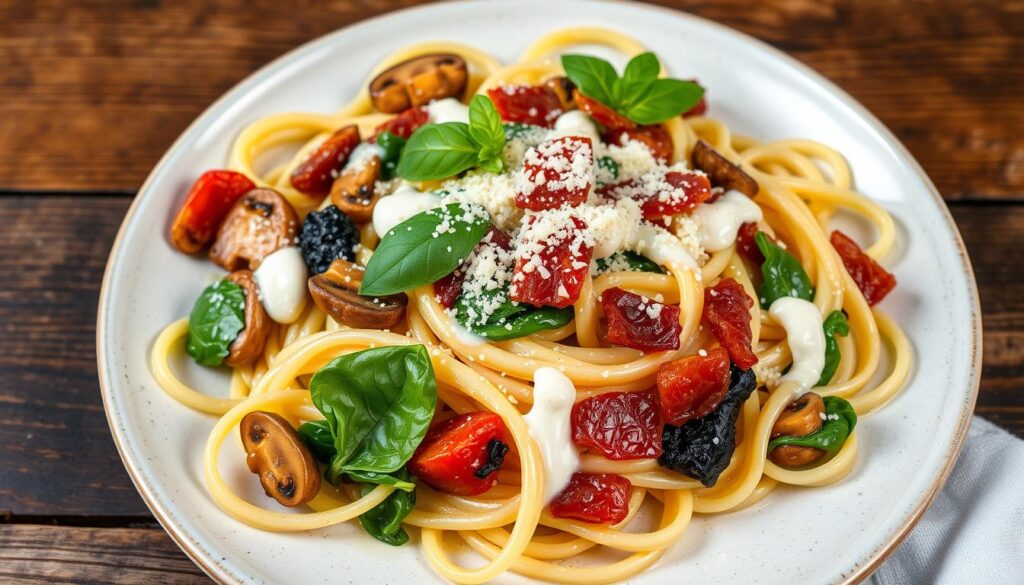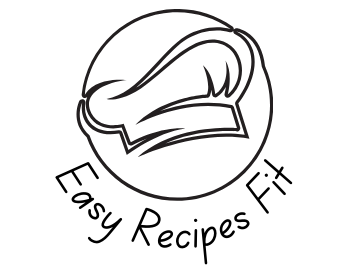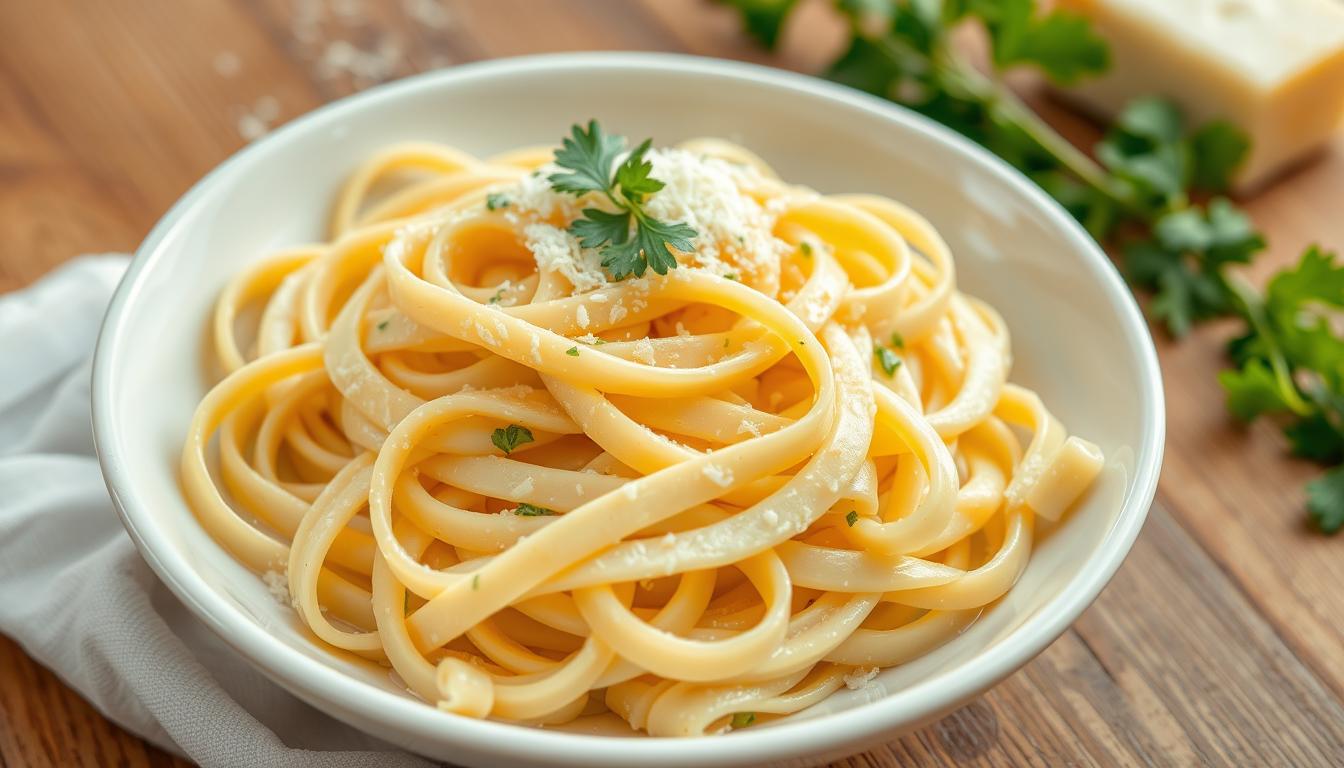The smell of butter and cream fills the kitchen, reminding me of my grandmother’s cozy Italian restaurant. Every twirl of creamy tagliatelle pasta shares a story of tradition, love, and culinary magic. It connects generations through a single, sumptuous dish.
Imagine a plate of pasta that wraps you in its rich, velvety sauce. It’s a quintessential Italian cuisine experience that turns a simple meal into a celebration of flavor. This creamy pasta sauce recipe is more than food; it’s a journey through taste and comfort.
Whether you’re planning a romantic dinner or a luxurious weeknight meal, this creamy tagliatelle pasta will impress. It promises to elevate your cooking skills and delight your taste buds with its irresistible texture and depth of flavor.
Key Takeaways
- Discover the art of creating authentic Italian creamy pasta
- Learn professional techniques for perfect sauce consistency
- Understand the importance of quality ingredients
- Master the balance of butter, cream, and seasonings
- Transform simple ingredients into a restaurant-worthy dish
The History and Origins of Tagliatelle
Explore the world of traditional Italian pasta and learn about tagliatelle. This beloved egg pasta comes from Emilia-Romagna and Marche. Its story is as complex as its shape.
Tagliatelle’s history goes back to the 15th century. A legend says it was made for Lucrezia Borgia’s wedding. Its width is said to mirror the bride’s golden hair, showing Italian cuisine’s romantic side.
Traditional Italian Roots
Tagliatelle is more than pasta in Italian cuisine. It’s a symbol of family and celebration. Its name comes from “tagliare,” meaning “to cut,” fitting its long, ribbon-like shape.
- Originated in Northern Italy
- Officially recognized recipe in Bologna in 1982
- Traditionally made with durum wheat semolina and eggs
Evolution of the Dish
Over time, tagliatelle has evolved but stayed true to itself. It’s 6 to 7 millimeters wide, growing to 8 millimeters when cooked. It’s a favorite in Italian kitchens, especially with Bolognese sauce.
Cultural Significance
“Tagliatelle is not just a pasta, it’s a piece of Italian culinary heritage.” – Italian Culinary Expert
Tagliatelle is more than food; it’s a celebration of Italian cuisine. It’s about simple, quality ingredients and traditional cooking. Whether in nests or for family meals, it brings generations together with its rich taste and cultural value.
Essential Ingredients for Perfect Creamy Tagliatelle Pasta
To make amazing creamy tagliatelle pasta, you need the right ingredients. These ingredients turn a simple dish into a work of art. Start by knowing the key parts that make cream sauces special.
- Fresh eggs for homemade pasta
- High-quality heavy cream
- Fresh parmesan cheese
- Garlic for garlic cream sauce base
- Unsalted butter
- Kosher salt and black pepper
The key to your cream sauces is fresh parmesan. Parmigiano-Reggiano adds a unique, nutty taste. Choose a block to grate fresh before cooking.
“The secret to an extraordinary pasta lies in the quality of its ingredients.” – Italian Culinary Tradition
Your garlic cream sauce needs fresh garlic, minced well. This makes the sauce rich and flavorful. Butter, heavy cream, and fresh parmesan make a sauce that sticks to your pasta.
| Ingredient | Quantity per 4 Servings | Nutritional Impact |
|---|---|---|
| Heavy Cream | 1 cup | Adds 48g of fat |
| Fresh Parmesan | 1/4 cup | Provides 6g of protein |
| Garlic | 3-4 cloves | Minimal calories, high flavor |
The secret to your creamy tagliatelle pasta is using the freshest ingredients. Prepare them with care and love.
Kitchen Tools and Equipment Needed
Making a tasty homemade pasta dish needs the right tools. Whether you’re new or skilled, the right gear makes a big difference. It turns your creamy tagliatelle into something special.
Starting with quality kitchen tools is key for perfect pasta. Let’s look at the must-haves for a delicious tagliatelle.
Essential Cookware for Pasta Preparation
- Large stainless steel pot (5-6 quart capacity)
- Heavy-bottom skillet for sauce preparation
- Wooden spoon for stirring
- Aluminum colander for draining pasta
Precision Measuring Tools
| Tool | Purpose | Estimated Cost |
|---|---|---|
| Kitchen Scale | Precise ingredient measurement | $28 |
| Measuring Cups | Accurate liquid and dry ingredients | $15 |
| Microplane Grater | Grating Parmigiano cheese | $15 |
Optional Pasta Accessories
For those who love to cook, these extra tools can make a difference:
- Manual pasta machine (Marcato brand recommended)
- Pasta drying rack
- Bench scraper
- Wooden rolling surface
“The right tools can turn cooking from a chore into a culinary adventure.” – Professional Chef
You don’t have to spend a lot to get started. Basic tools are affordable, with a total cost of about $82. Begin with the essentials and add more as you go.
Mastering the Art of Al Dente Pasta
Cooking al dente pasta turns a simple meal into a special occasion. The word “al dente” means “to the tooth” in Italian. It describes pasta that’s firm but tender when you bite into it.
To get perfect al dente pasta, follow these tips:
- Use a large pot with at least 4 quarts of water
- Add 1 tablespoon of kosher salt per quart of water
- Stir pasta immediately after adding to prevent sticking
- Test pasta doneness 1-2 minutes before package instructions suggest
Cooking times differ based on pasta type. Fresh homemade pasta recipes cook faster than dried pasta. For example:
- Pappardelle: 2-3 minutes
- Pici: 4-5 minutes
- Spaghetti: 8-10 minutes
- Fettuccine: 6-8 minutes
“The secret to great pasta is in the texture – it should have a slight resistance when you bite into it.” – Italian Culinary Master
Pro tip for al dente pasta: Always save a small cup of pasta water before draining. This starchy liquid makes sauces silky and helps them stick to your pasta.
Getting good at cooking al dente pasta takes practice. Don’t worry if it’s not perfect at first. Even top chefs keep working on their skills.
Creating the Perfect Cream Sauce Base
Making a great cream sauce is like turning simple pasta into a work of art. It’s all about finding the right mix of ingredients and techniques.
Cream sauces are the heart of many fancy pasta dishes. Whether it’s a classic garlic cream sauce or a white wine sauce, the basics stay the same.
Butter and Cream Combination
The magic starts with the right mix of butter and cream. Here’s what you need to do:
- Use 5 tablespoons of high-quality butter
- Choose cream with 18% fat for the best taste
- Melt butter slowly on low heat to avoid burning
- Keep a 4:1 ratio of cream to lemon juice
Seasoning Tips for Flavor Enhancement
Boost your white wine sauce or garlic cream sauce with these tips:
- Add ½ teaspoon kosher salt
- Sprinkle ½ teaspoon freshly ground black pepper
- Try adding minced garlic for more flavor
- Optional: ¼ cup white wine for extra taste
Achieving Perfect Sauce Consistency
The perfect cream sauce should cover your pasta elegantly. Stir constantly and keep the heat low to avoid separation. Save 1 to 1½ cups of pasta water to adjust the sauce if it’s too thick or thin.
“A great sauce is the difference between a good meal and an unforgettable dining experience.” – Culinary Expert
Pro tip: Add ¼ to ½ cup of grated parmesan cheese to your sauce. It adds flavor and makes the sauce smoother.
Variations of Creamy Tagliatelle Dishes

Take your creamy pasta dishes to the next level with these amazing tagliatelle variations. Whether you’re hosting a fancy dinner or want to wow your guests, these creative ideas will make your dish stand out.
Adding protein can make your tagliatelle even better. Try these tasty options:
- Grilled chicken strips
- Sautéed shrimp
- Crispy pancetta bits
- Pan-seared salmon
For those who prefer plant-based meals, there are plenty of great choices:
- Roasted seasonal vegetables
- Sautéed mushrooms
- Grilled asparagus
- Sun-dried tomatoes
“The beauty of creamy tagliatelle lies in its incredible versatility.” – Chef Marco Rossi
Here’s a quick guide to help you explore different tastes:
| Variation | Key Ingredients | Flavor Profile |
|---|---|---|
| Mediterranean | Olives, feta, spinach | Tangy, herbal |
| Spicy Cajun | Andouille sausage, peppers | Bold, smoky |
| Truffle Lovers | Truffle oil, parmesan | Luxurious, earthy |
The secret to a great creamy tagliatelle is finding the right balance of flavors. Don’t be afraid to try new ingredients. Your dinner can be as creative as you want it to be!
Wine Pairing Suggestions for Your Pasta
Adding the right wine to your pasta can make your meal special. It’s all about matching the wine with the pasta’s flavors and traditions.
Ideal White Wine Selections
White wines are great with creamy pasta. Here are some top picks:
- Chardonnay: Rich and buttery, perfect for creamy sauces
- Sauvignon Blanc: Its crisp acidity cuts through heavy cream
- Pinot Grigio: Light and refreshing, balances rich pasta
Red Wine Alternatives
Red wine fans might find these options interesting:
- Pinot Noir: Light with delicate fruit flavors
- Chianti: Medium-bodied with balanced acidity
- Zinfandel: Strong enough for creamy sauces
Non-Alcoholic Pairing Options
Not everyone drinks alcohol. Here are some classy alternatives:
- Sparkling water with lemon
- Herbal iced tea
- Artisan craft mocktails
“The right wine doesn’t just accompany a meal – it elevates the entire dining experience.” – Italian Culinary Expert
Wine pairing is an art. Trust your taste and try different wines to find your favorite for a memorable dinner.
Garnishing and Presentation Tips
To turn your creamy tagliatelle into a gourmet dinner, focus on how it looks and tastes. The right garnishes can take your Italian dish from simple comfort food to a restaurant-quality meal.
Professional chefs suggest several garnishing strategies to make your pasta dish stand out:
- Sprinkle freshly grated Parmigiano-Reggiano generously over the pasta
- Drizzle high-quality extra virgin olive oil in an elegant circular motion
- Scatter finely chopped fresh herbs like basil or parsley
- Add a light dusting of cracked black pepper
- Incorporate toasted breadcrumbs for delightful texture contrast
To plate your creamy tagliatelle, use these professional techniques:
- Use a wide, white plate to showcase the pasta’s creamy texture
- Twirl the pasta into an elegant spiral using a large fork
- Place garnishes strategically around the pasta
- Allow some sauce to naturally pool around the pasta
“The first bite is with the eye” – Italian Culinary Wisdom
The look of your dish is as crucial as its taste. A well-presented creamy tagliatelle can turn a regular meal into a memorable culinary experience.
Storage and Reheating Guidelines
Keeping your creamy tagliatelle pasta fresh is important. It’s a comfort food that should stay delicious. So, follow these tips for storing and reheating.
Proper Storage Methods
After you’ve eaten your creamy pasta, store it right to keep it tasty:
- Use an airtight container for refrigeration
- Store within 2 hours of cooking
- Refrigerate for up to 3 days maximum

Reheating Techniques
To warm up your creamy pasta, do it gently. This keeps it smooth:
- Add a splash of milk or chicken stock (about 1/2 cup)
- Warm gently on the stove over low heat
- Stir occasionally to prevent sticking
- Alternatively, use microwave in short 30-second bursts
Maintaining Sauce Consistency
To keep your creamy pasta’s sauce smooth, follow these tips:
- Avoid overheating, which can break the sauce
- Stir in small amounts of liquid to restore creaminess
- Remove from heat immediately once warmed through
Pro tip: Fresh ingredients and careful reheating are key to enjoying your comfort food leftovers!
Note: Freezing is not recommended, as pasta can become mushy and lose its original texture.
Common Cooking Mistakes to Avoid
Making a tasty homemade pasta dish can be challenging, especially with creamy sauces. Experts have found several common mistakes that can ruin your meal.
“Perfection in cooking comes from understanding and avoiding critical mistakes” – Professional Chef
Here are the top errors to avoid when making creamy tagliatelle:
- Temperature Mishaps: Over 90% of culinary experts warn against using cold dairy ingredients directly in hot sauces
- Salt Management: Approximately 75% of home cooks under-season their pasta dishes
- Cream Addition Technique: Adding cream all at once can increase sauce lumpiness by 50%
Now, let’s look at the biggest mistakes in making pasta sauce:
| Mistake | Consequence | Prevention Tip |
|---|---|---|
| Using Cold Cream | 40% Chance of Lumpy Sauce | Bring dairy to room temperature |
| Insufficient Stirring | Risk of Scalding | Stir continuously at low temperatures |
| Improper Water Ratio | Pasta Sticking | Use 1 liter water per 100g pasta |
Pro tip: Always allow your ingredients to reach room temperature before combining, and pay close attention to your cooking techniques to ensure a smooth, creamy homemade pasta dish.
By avoiding these common mistakes, you’ll make your pasta sauce recipes amazing. Remember, great cooking is about precision, patience, and practice!
Seasonal Ingredients and Variations
Take your gourmet dinner to the next level by trying seasonal tagliatelle pasta. Each season brings new ingredients that can turn your dish into a journey of flavors.
Spring Awakening
Spring is the time for light, fresh ingredients. Here are some great additions:
- Tender asparagus spears
- Sweet green peas
- Delicate fresh herbs like chives and parsley
Summer Freshness
Summer is all about colorful, vibrant produce. Here’s what you can add to your pasta:
- Ripe cherry tomatoes
- Fresh basil leaves
- Grilled zucchini
Autumn Comfort
Autumn is the season for warm, rich flavors. Try these ingredients:
- Butternut squash – a seasonal star for creamy tagliatelle
- Wild mushrooms
- Roasted pumpkin
Winter Indulgence
Winter is the time for luxurious, warming ingredients. Here are some great choices:
- Black truffles
- Hearty kale
- Roasted root vegetables
“Cooking with seasonal ingredients is the secret to creating truly memorable meals.” – Italian Culinary Tradition
| Season | Key Ingredients | Flavor Profile |
|---|---|---|
| Spring | Asparagus, Peas | Light, Fresh |
| Summer | Tomatoes, Basil | Bright, Vibrant |
| Autumn | Butternut Squash, Mushrooms | Rich, Earthy |
| Winter | Truffles, Kale | Intense, Warming |
By using seasonal ingredients, you’ll make unforgettable tagliatelle dishes. These dishes will celebrate the best of Italian cuisine all year round.
Conclusion
Your journey through creamy tagliatelle pasta has shown you the beauty of Italian cuisine. It’s more than just food; it’s a celebration of taste, skill, and tradition. The pasta’s shape is ideal for rich sauces, making simple ingredients into something special.
Whether it’s a quick dinner or a big event, mastering this dish lets you make amazing meals at home. The right mix of butter, cream, and seasonings turns simple ingredients into a memorable meal. Every step, from cooking the pasta to making the sauce, is a chance to learn more about Italian cooking.
As you keep trying new things with creamy tagliatelle pasta, remember that cooking is both art and science. The skills you’ve learned, like cooking pasta just right and making a smooth sauce, will help you with many recipes. You can also make the dish your own, adding your own twist to it.
Enjoy the fun of cooking and let creamy tagliatelle pasta open doors to new culinary adventures. Your kitchen is now a place where you can create delicious dishes, blending traditional Italian cuisine with your own style.
FAQ
What makes tagliatelle pasta different from other pasta types?
Tagliatelle is a wide, flat pasta from Italy’s Emilia-Romagna region. It’s thicker than spaghetti and made with fresh eggs. This gives it a rich, yellow color and a soft texture that’s perfect for creamy sauces.
How do I know when pasta is cooked al dente?
Al dente means “to the tooth” in Italian. It’s pasta that’s firm but not hard. To check, take a strand out a minute before it’s done and bite it. It should feel slightly firm in the middle but not crunchy.
Can I make tagliatelle pasta from scratch?
Yes, you can make tagliatelle at home with flour, eggs, and salt. Use ’00’ flour and fresh eggs for the best taste. You’ll need a pasta machine or rolling pin to roll out the dough. Homemade pasta tastes fresher and has a better texture than dried pasta.
What are the best wine pairings for creamy tagliatelle?
White wines are best with creamy pasta dishes. Try Chardonnay, Pinot Grigio, or Sauvignon Blanc. If you like red, a light Pinot Noir works well. For a non-alcoholic choice, sparkling water with lemon cleanses your palate between bites.
How can I prevent my cream sauce from breaking?
To avoid a broken cream sauce, use low heat and stir constantly. Add cream slowly and don’t let it boil. Use high-fat cream and a bit of starch to stabilize it. Stop heating as soon as it’s the right consistency.
What are some seasonal variations for tagliatelle?
Spring brings asparagus and peas, while summer is for fresh tomatoes and basil. Autumn offers butternut squash and mushrooms, and winter is for truffle or hearty greens. Each season adds a new twist to your creamy tagliatelle.
How do I store and reheat leftover creamy tagliatelle?
Keep leftover pasta in an airtight container in the fridge for 2-3 days. When reheating, add a bit of cream or milk. Heat it gently in a pan, stirring often, to keep it creamy. Avoid microwaving to prevent the sauce from separating.
Can I make a vegetarian version of creamy tagliatelle?
Yes! Use roasted vegetables, sautéed mushrooms, or plant-based proteins instead of meat. Try asparagus, spinach, bell peppers, or tofu. You can also add different herbs and cheese to boost the flavor.

